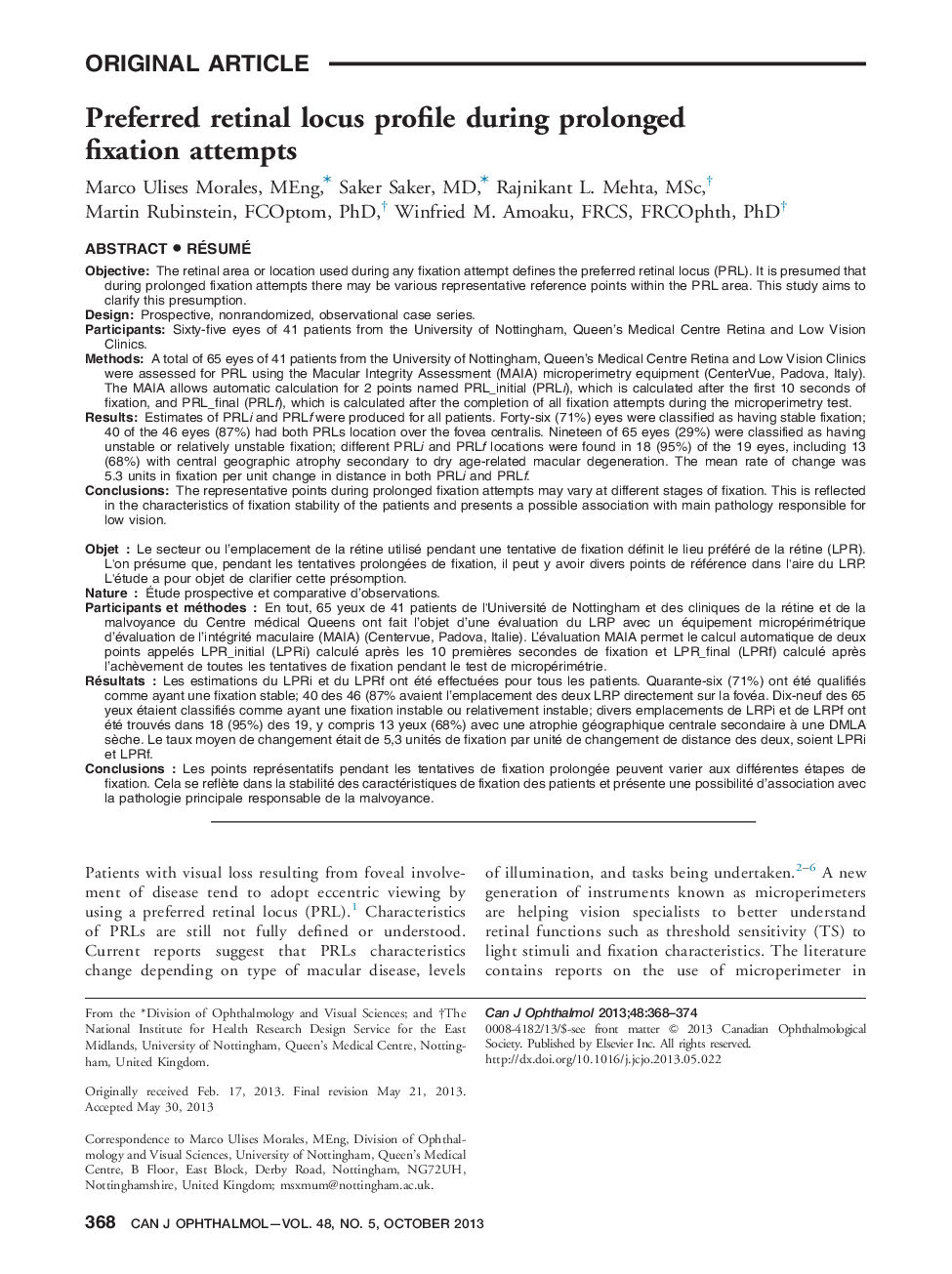| کد مقاله | کد نشریه | سال انتشار | مقاله انگلیسی | نسخه تمام متن |
|---|---|---|---|---|
| 4009460 | 1602407 | 2013 | 7 صفحه PDF | دانلود رایگان |

ObjectiveThe retinal area or location used during any fixation attempt defines the preferred retinal locus (PRL). It is presumed that during prolonged fixation attempts there may be various representative reference points within the PRL area. This study aims to clarify this presumption.DesignProspective, nonrandomized, observational case series.ParticipantsSixty-five eyes of 41 patients from the University of Nottingham, Queen’s Medical Centre Retina and Low Vision Clinics.MethodsA total of 65 eyes of 41 patients from the University of Nottingham, Queen’s Medical Centre Retina and Low Vision Clinics were assessed for PRL using the Macular Integrity Assessment (MAIA) microperimetry equipment (CenterVue, Padova, Italy). The MAIA allows automatic calculation for 2 points named PRL_initial (PRLi), which is calculated after the first 10 seconds of fixation, and PRL_final (PRLf), which is calculated after the completion of all fixation attempts during the microperimetry test.ResultsEstimates of PRLi and PRLf were produced for all patients. Forty-six (71%) eyes were classified as having stable fixation; 40 of the 46 eyes (87%) had both PRLs location over the fovea centralis. Nineteen of 65 eyes (29%) were classified as having unstable or relatively unstable fixation; different PRLi and PRLf locations were found in 18 (95%) of the 19 eyes, including 13 (68%) with central geographic atrophy secondary to dry age-related macular degeneration. The mean rate of change was 5.3 units in fixation per unit change in distance in both PRLi and PRLf.ConclusionsThe representative points during prolonged fixation attempts may vary at different stages of fixation. This is reflected in the characteristics of fixation stability of the patients and presents a possible association with main pathology responsible for low vision.
RésuméObjetLe secteur ou l’emplacement de la rétine utilisé pendant une tentative de fixation définit le lieu préféré de la rétine (LPR). L'on présume que, pendant les tentatives prolongées de fixation, il peut y avoir divers points de référence dans l'aire du LRP. L'étude a pour objet de clarifier cette présomption.NatureÉtude prospective et comparative d’observations.Participants et méthodesEn tout, 65 yeux de 41 patients de l'Université de Nottingham et des cliniques de la rétine et de la malvoyance du Centre médical Queens ont fait l’objet d’une évaluation du LRP avec un équipement micropérimétrique d’évaluation de l’intégrité maculaire (MAIA) (Centervue, Padova, Italie). L’évaluation MAIA permet le calcul automatique de deux points appelés LPR_initial (LPRi) calculé après les 10 premières secondes de fixation et LPR_final (LPRf) calculé après l’achèvement de toutes les tentatives de fixation pendant le test de micropérimétrie.RésultatsLes estimations du LPRi et du LPRf ont été effectuées pour tous les patients. Quarante-six (71%) ont été qualifiés comme ayant une fixation stable; 40 des 46 (87% avaient l’emplacement des deux LRP directement sur la fovéa. Dix-neuf des 65 yeux étaient classifiés comme ayant une fixation instable ou relativement instable; divers emplacements de LRPi et de LRPf ont été trouvés dans 18 (95%) des 19, y compris 13 yeux (68%) avec une atrophie géographique centrale secondaire à une DMLA sèche. Le taux moyen de changement était de 5,3 unités de fixation par unité de changement de distance des deux, soient LPRi et LPRf.ConclusionsLes points représentatifs pendant les tentatives de fixation prolongée peuvent varier aux différentes étapes de fixation. Cela se reflète dans la stabilité des caractéristiques de fixation des patients et présente une possibilité d’association avec la pathologie principale responsable de la malvoyance.
Journal: Canadian Journal of Ophthalmology / Journal Canadien d'Ophtalmologie - Volume 48, Issue 5, October 2013, Pages 368–374